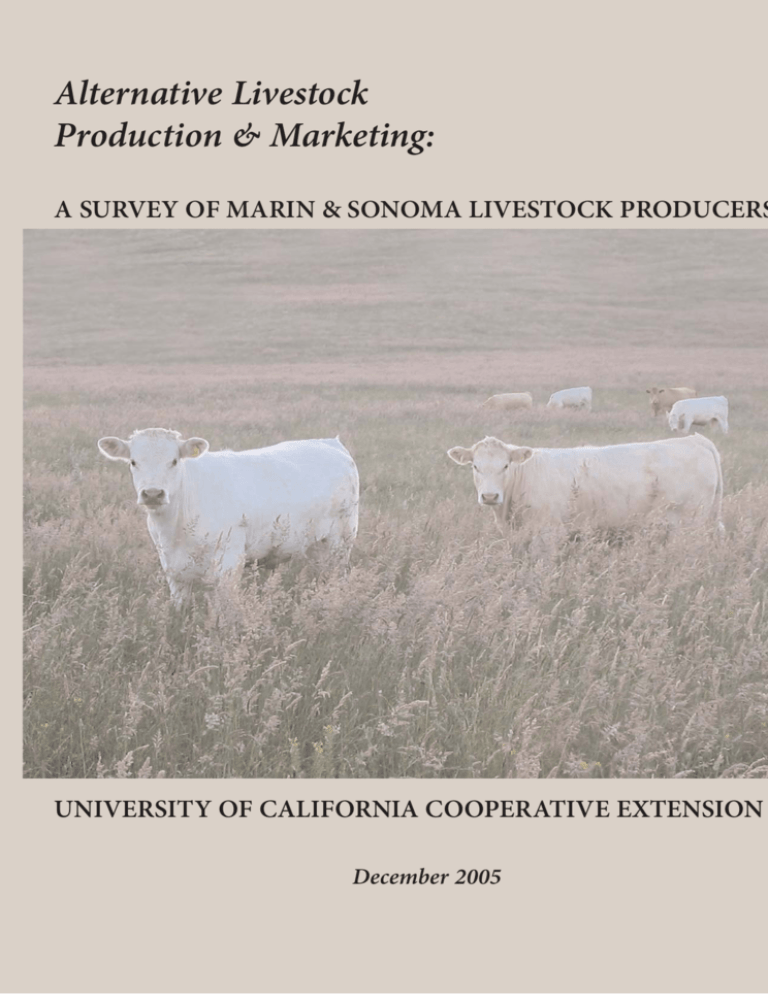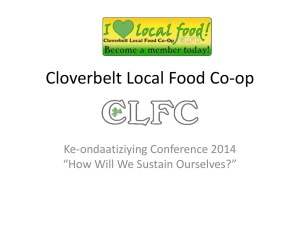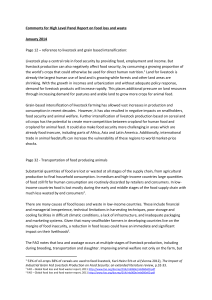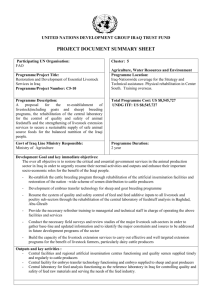Alternative Livestock Production & Marketing
advertisement

Alternative Livestock Production & Marketing: A SURVEY OF MARIN & SONOMA LIVESTOCK PRODUCERS UNIVERSITY OF CALIFORNIA COOPERATIVE EXTENSION December 2005 ALTERNATIVE LIVESTOCK PRODUCTION AND MARKETING: A Survey of Marin and Sonoma Livestock Producers Prepared by: Lauren Gwin, Doctoral Candidate, University of California, Berkeley Stephanie Larson, Livestock & Natural Resources Advisor, UCCE Marin & Sonoma Ellie Rilla, Director, UCCE Marin County Lisa Bush, Agricultural and Range Management Consultant Funded by the: Rathmann Family Foundation County of Marin University of California Communities Student Intern Program December 2005 Acknowledgements We gratefully acknowledge the assistance of the farmers and ranchers who reviewed this survey and to all who participated in the survey. Also, thanks to Isaac Cunningham, our student intern, for managing the survey and analyzing the data. The Sonoma UCCE office was most helpful in providing mailing lists for the Sonoma producers. Project Coordinators Stephanie Larson and Ellie Rilla Survey and Data Development Stephanie Larson, Isaac Cunningham, Lauren Gwin, and Frances Healey Writing and Editorial Assistance Lisa Bush Layout and Design Steve Quirt and Frances Healey Cover Photograph Steve Quirt Survey Review Stephanie Larson, Lisa Bush, Lauren Gwin, Kevin Lunny, Peggy Rathmann, Ellie Rilla, and John Wick University of California Cooperative Extension 1682 Novato Boulevard, Suite 150B Novato, CA 94947 415/499-4204 Additional copies of this report can be accessed from the website: http:cemarin.ucdavis.edu Livestock Working Group Mission Statement: The goal of the natural and organic livestock workgroup is to provide support to local ranchers and livestock managers, provide education to local producers and consumers on the latest changes and development in livestock processing, and to establish standards for local producers, in order to help the local producers create the specialty meat niche market. Members of this informal group have been meeting since 2002. Producers: Bill Barboni, Jr. David Evans Mike Gale Liz Griffin Kevin Lunny Mark Pasternak Al Poncia Albert Straus Amanda Wisby Others: Helge Hellberg, Marin Organic Tony Nelson, Marin Agricultural Land Trust John Wick Peggy Rathmann Agricultural Commissioner’s Office: Stacy Carlsen, Marin Agricultural Commissioner Anita Sauber, Inspector UCCE/Farm Advisor’s Office: Steve Quirt, Organic and Sustainable Agriculture Coordinator Ellie Rilla, County Advisor Stephanie Larson, Livestock and Range Management Advisor Table of Contents EXECUTIVE SUMMARY ................................................................................. 2 Highlights ........................................................................................................... 2 BACKGROUND AND INTRODUCTION..................................................... 4 SURVEY METHODS AND GOALS ................................................................ 4 MAIL SURVEY RESPONSES............................................................................ 5 Basic profile........................................................................................................ 5 Primary marketing methods ............................................................................ 7 Use of local slaughter and processing facilities.............................................. 7 Slaughter............................................................................................................. 8 Processing........................................................................................................... 8 Specialty markets............................................................................................... 9 Obstacles............................................................................................................. 9 Educational opportunities and UCCE..........................................................10 SMALL GROUP MEETINGS..........................................................................10 How they market currently ............................................................................11 Alternative marketing options.......................................................................11 Constraints .......................................................................................................12 What UCCE and other support institutions can do ...................................14 NEXT STEPS .....................................................................................................14 Progress has already been made ....................................................................15 CONCLUSION..................................................................................................16 REFERENCES....................................................................................................16 Alternative Livestock Production and Marketing y December 2005 1 EXECUTIVE SUMMARY Consumer demand for non-commodity, or “alternative” foods with various attributes—local, natural, certified organic, grass-fed, artisan, and others—is growing nationwide. The San Francisco Bay region is on the leading edge of this trend. A growing number of innovative producers in our area are eager to meet this demand, yet they face significant constraints. The production knowledge needed to make these changes is only one issue. On top of this, new farm products can require major financial investments, additional slaughter and processing1 infrastructure, marketing skills, and a host of other resources to which many farmers and ranchers have limited access. Exploring niche markets for local livestock producers has been a priority for University of California Cooperative Extension (UCCE) for several reasons. First, a vast majority of the agricultural land in Marin and Sonoma Counties is used for livestock production. Second, beef cattle ranching, a major component of this land use is only marginally profitable: many acres of Marin and Sonoma’s agricultural landscape are in danger of being lost to non-agricultural uses if they cannot sustain profitable agricultural enterprises. In the spring and summer of 2005, UC Cooperative Extension (UCCE) surveyed livestock producers in Marin and Sonoma counties, using a mail survey and small group meetings. The goal of the project was to determine (1) producer interest in alternative marketing opportunities; (2) barriers they face in taking advantage of these opportunities; and (3) how local government and resource agencies can help with potential changes. This survey was commissioned by the Livestock Working Group (Byron 2002), which is made up of livestock producers, county officials, UCCE staff, and others. The Working Group has met on a regular but informal basis since 2002, to explore alternative production and marketing options and challenges for our region’s livestock producers. Highlights: ¾ More than half of the 152 respondents expressed interest in selling to specialty markets, by using different kinds of production and different marketing channels. The most popular production option was “100% grass fed” and the most popular marketing channel was “direct to the consumer.” ¾ More than half of all respondents use on-farm slaughter for at least some of their animals and nearly all use this meat for home consumption. 1 In this report, we distinguish “slaughter” from “processing”: “processing” refers to the post-slaughter cutting of meat for sale, but it can also include other preparations (smoking, grinding, e.g.). “Cut and wrap” is a term often used to describe post-slaughter processing, but for consistency’s sake, we do not use it here. 2 Alternative Livestock Production and Marketing y December 2005 ¾ A “lack of marketing channels and distribution network” was the top-ranked obstacle to accessing specialty markets. The process and cost of certification (grass-fed or organic) were ranked #2 and #3, and a current lack of slaughter and processing infrastructure was #4. The lowest ranked obstacles were production knowledge and concern about risk. All of these obstacles, and others, were discussed extensively in the small group sessions. ¾ Producers need help deciphering current marketing options. They especially need clarity on the requirements of certification programs (including but not limited to the grass-fed and organic certification programs available to producers in both counties) and regulations concerning slaughter, processing, and sales. ¾ While some producers want to begin or expand direct market sales, others prefer to focus on production and leave the marketing to a person or group with those skills. ¾ Producers asked for UCCE and others to provide information on a variety of topics, including specifics on marketing options, slaughter and processing regulations, and production issues. Alternative Livestock Production and Marketing y December 2005 3 BACKGROUND AND INTRODUCTION Our region faces multiple constraints in developing new markets for locally produced meat. Among the most significant of these are limited slaughter and processing facilities and marketing channels. These limitations, though currently manageable for the few producers that are already exploring new markets, are a critical barrier to further development of locally produced and marketed specialty meat products. Limitations include: ¾ Our region’s only United States Department of Agriculture (USDA)-inspected slaughter facility for cattle, Rancho Veal, has been sold, and the land is slated for housing development; Rancho will be gone in two to three years. ¾ Our region’s only USDA-inspected processing facility for cattle (Hagemann’s) is quickly reaching the physical limits of its capacity. ¾ Our region’s only USDA-inspected slaughter and processing facility for sheep and goats (Panizzera) may also be near its limits. ¾ Producers are interested in selling “freezer meat”2 directly to the consumer, but regulations are difficult for producers to understand, and this option appears to be limited by a lack of appropriate slaughter and processing facilities.3 Both producers and consumers are interested in this marketing option, and both are asking for clarification and help. These challenges and constraints are both serious and timely. They require attention and involvement from both private and public groups and individuals. Government agencies and non-governmental organizations are needed to assist the producers and consumers in our region who want to grow and purchase alternative livestock products. While “market forces” are, and will continue to be important mechanisms for change, such forces must be supplemented by supportive and appropriate public policy. SURVEY METHODS AND GOALS In the spring and summer of 2005, UC Cooperative Extension (UCCE) surveyed livestock producers in Marin and Sonoma counties, using a mail survey and small group meetings. The goal of the survey was to determine (1) producer interest in alternative marketing opportunities; (2) barriers they face in taking advantage of these opportunities; and (3) how local government and resource agencies can help with potential changes. 2 “Freezer meat,” also called “locker meat,” refers to bulk sales of meat, typically by the whole, half, or quarter carcass, including a variety of cuts, direct from rancher to consumer. In this way, producers are able to sell all cuts, not just the more popular cuts (e.g. steaks). 3 On-farm slaughter, though not legal for commercial use, is viewed by some producers and consumers as more humane than transporting animals to off-farm slaughter. 4 Alternative Livestock Production and Marketing y December 2005 This survey was commissioned by the Livestock Working Group (the Working Group), which is made up of livestock producers, county officials, UCCE staff, and others. The Working Group has met on a regular but informal basis since 2002, to explore alternative production and marketing options and challenges for our region’s livestock producers. In April 2005, UCCE mailed a survey to 482 livestock producers in both counties. In August, two meetings were held with smaller, self-selected groups of producers. The goals of the survey and the meetings were to: 1) Assess producer needs and issues; 2) Ascertain interest in alternative production, processing, and marketing opportunities. 3) Gather data about producers’ current processing and distribution systems and potential future needs or wants; 4) Gauge their interest in learning more about related topics, and determine how they would like to receive this information. An overarching goal of this project was to help local research and educational agencies, such as UCCE, design future programs, especially around alternative marketing, to best meet producer needs and, more broadly, to support innovative approaches to sustain and enhance the vitality of our region’s agricultural communities and landscapes. MAIL SURVEY RESPONSES The response rate to the mail survey was ~30%, with 152 respondents. Respondents are generally representative of the counties’ livestock producers, and a majority of the larger (in numbers of animals) producers participated in the survey. Basic profile Our survey is weighted, in numbers of respondents, toward Sonoma County producers, with 58% farming or ranching solely in Sonoma County versus 27% in Marin County, and 13% with operations in both counties. The vast majority (80%) are family farms. Half of respondents said that farming or ranching was their principal occupation. More than two-thirds (72%) of respondents are male. The average age is 55, and the average number of years farming or ranching is 34. Most (78%) are the owners of their operations (as opposed to partners, managers, or lessees). Nearly two-thirds (63%) report that their operations are either financially viable, meeting their life goals, or both. In the long run, respondents appear fairly evenly concerned about generational transfer (32%) and taxes (31%), with market conditions (39%) causing slightly more concern. More than a third of respondents also Alternative Livestock Production and Marketing y December 2005 5 mentioned other issues, from rising input prices, to development pressure and environmental regulations, to their own age and health. Size of operation, in acres owned and leased, is consistent with earlier surveys of Marin and Sonoma County livestock operations. The average size, in owned land, is 429 acres. Half of respondents also lease land, and the average size of a leased property is 1,297 acres. As both owners and lessees, respondent farms and ranches cover a total of 148,301 acres in the two counties. Cow-calf operations4 (83 respondents) outnumber all other operation types, followed by sheep (59), dairy (29), dairy replacement5 (16), stocker cattle6 (11), poultry (8), goats (6), and hogs (3).7 However, in actual number of head, dairy cattle, including both milk cows and dairy replacements, outnumber all other types of livestock (Table 1). Table 1. Total number of livestock reported 8,882 Dairy 6,187 Cow-calf 967 Stocker cattle 6,601 Sheep 437 Poultry 3,438 Dairy replacement Goats 47 Hogs 5 Other 14 4 Cow-calf operations involve year-round raising of mother cows, and seasonal birthing, raising, and selling of calves (the crop). Dairy replacement operations raise young female cows to replace older dairy cows that are no longer productive. 6 Stocker operations purchase young cattle too small to be slaughtered and raise them on pasture until they reach an adequate size to go to a feedlot or directly to slaughter. 7 Some respondents raise more than one type of livestock. This kind of overlap is common in this dataset. 5 6 Alternative Livestock Production and Marketing y December 2005 Average herd sizes as seen in Table 2, below, are also consistent with earlier surveys. Table 2: Average herd size Hogs Goats Dairy replacement Poultry Sheep Stocker cattle Cow/calf Dairy 0 50 100 150 200 250 300 350 Primary marketing methods Respondents reported a variety of ways to market their livestock, and most used more than one method. The two most common ways are through a livestock auction (70%) and to an individual livestock buyer (49%). Interestingly, 39% report selling directly to individuals, though only one respondent sells at a farmers market. These direct sales, which account for only 6% of the animals sold annually for slaughter, may well be on-farm, neighbor to neighbor sales, and not through formal market channels. (In addition, some “direct” sales are of live animals, often for breeding, which skews the data.) Only two respondents sell to retail stores or restaurants. The number of animals sold annually for slaughter varies widely among respondents, ranging from none to 600, the latter reported by a joint cow-calf/stocker operation. The average, for operations of all types, is 78 animals sold per year. Use of local slaughter and processing facilities One goal of the survey was to learn how many producers use the local USDA-inspected slaughter plants (Rancho Veal, in Petaluma, for cattle; Panizzera, in Occidental, for sheep) and the local USDA-inspected processing facility (Hagemann’s Meats), all of which are in Sonoma County. We particularly hoped to learn how many producers will be affected when Rancho Veal closes, expected within two to three years. Apparent confusion over the wording of survey questions about local slaughter and processing means that our data are limited on this topic. We believe this is due, in part, to a lack of clarity among producers on the differences between federal (USDA) and state (California Department of Food and Agriculture (CDFA)) slaughter and processing regulations. The small group Alternative Livestock Production and Marketing y December 2005 7 meetings, reported on below, certainly support this notion, while also giving us a more detailed snapshot of local slaughter and processing. Slaughter Three different types of slaughter exist in California: custom exempt, which is done on-farm for the producer; state-inspected custom slaughter which can be used for animals that are sold live by the producer; and USDA-inspected slaughter.8 Of the 152 survey respondents, 44 use Rancho Veal, thus the fallout from Rancho’s closure is likely to be significant. Quite a few producers use USDA-inspected slaughter plants in other areas including Dixon, Fresno, and Gilroy. Still others use state-licensed, custom slaughter facilities in other areas. Animals that are sold live by the producer can be slaughtered at such slaughter facilities. However, neither of our two counties has a custom slaughter facility.9 One very interesting finding concerns on-farm slaughter, done by custom exempt mobile slaughterers. Half of all respondents (79) say they use on-farm slaughter. Of this subgroup, a third (29%) sell meat or other products from animals slaughtered on-farm. Less surprisingly, nearly all (93%) report using on-farm slaughter for home consumption. The bottom line is that the two local USDA-inspected slaughter facilities are reaching or at capacity. When Rancho Veal is closed and converted to residential development, the lack of a local USDA cattle slaughter facility will have a severe impact on local producers. Processing Meat processing can be done under four different types of licenses or inspections: USDA, state, custom-exempt, and retail outlets inspected by the County Environmental Health Service (CEHS). Twenty survey respondents have processing done at Hagemann’s, the only USDAinspected processing facility in our two counties. Other respondents use facilities that do customexempt and/or state-inspected processing.10 8 Regulations for slaughter and processing will be further clarified in an upcoming report, but brief explanations may be useful here. Custom-exempt mobile slaughterers, also called “Farmer’s helpers” or “A-framers,” are required to be registered by the state brand inspector to do on-farm slaughter. They do not perform animal or meat inspection, however, and meat slaughtered onfarm is intended for use only by the owner, which in this case means specifically the livestock producer, and members of the producer’s household, non-paying guests, and employees. In contrast, “custom” slaughter is performed at a facility that is inspected by CDFA for the owner of the animal. In this case, the owner may be the livestock producer OR an individual (or group of individuals) who bought that animal live from the producer. 9 There are nearly 50 custom slaughter facilities in the state, most located near Interstate 5. The one nearest to Marin and Sonoma is in Yolo County. 10 As noted above, processing regulations will be clarified in an upcoming report. In brief, meat processed at custom exempt facilities cannot be resold. Custom exempt or state-inspected processing facilities appear to be sufficient for direct-to-consumer sales of freezer meat slaughtered at either a USDA-inspected facility or at a state-inspected custom slaughter facility. However, for meat to be sold wholesale, it must be processed at a USDA-inspected facility. Retail facilities inspected by CEHS (grocery store butcher counters, e.g.) can process and sell USDA-inspected slaughtered meat and can wholesale up to 25% of that meat on site to hotels, restaurants, and institutions. 8 Alternative Livestock Production and Marketing y December 2005 Specialty markets Half of the survey respondents plan to do something new in the next one to five years, and this may mean changes in marketing. Just over half (57%), including producers of all livestock species, expressed interest in selling to specialty markets (Table 3). Of the seven specialty market options we listed (which included both production methods and marketing channels) the option that most respondents were interested in was 100% grass-fed (57%), followed by natural (44%), direct to the consumer (35%), certified organic (30%), restaurants (19%), branded programs (27%), and retail (12%). Table 3. Interest in specialty markets Retail stores Restaurants Direct to consumer Branded programs Certified organic Natural 100% Grass-fed 0 10 20 30 40 50 60 Percentage of respondents Obstacles We asked producers what obstacles they face in getting into these specialty markets (Table 4). The top-ranked obstacle cited is a lack of marketing channels and distribution network. Certification process and costs (for grass-fed or organic) were #2 and #3, respectively. Lack of processing infrastructure ranked #411. The least cited obstacles are production knowledge (#5) and concern about risk (#6). 11 The relatively low ranking of this obstacle may indicate producers’ lack of knowledge of the regulations, thus their lack of understanding of how significant this obstacle may actually be. Alternative Livestock Production and Marketing y December 2005 9 Table 4. Obstacles to specialty markets Lack of marketing channels, distribution network Certification process Certification cost Other Lack of processing infrastructure Concern about risk Production knowledge 0 5 10 15 20 25 30 35 40 # of respondents Our data show no obvious correlation between particular obstacles and particular species. That is, “production knowledge” is not cited only by goat producers, for example, and producers of all species report that they face a lack of markets, distribution channels, and infrastructure. Educational opportunities and UCCE Finally, producers suggested a wide range of educational opportunities they wished UCCE to provide, on topics in production, marketing, regulations, business planning, and more. We explored these ideas further with the small groups. SMALL GROUP MEETINGS On August 4 and 5, 2005, UCCE hosted small group meetings for Marin and Sonoma livestock producers, about alternative marketing, opportunities, and challenges.12 Eight producers (cowcalf and sheep) came to the Santa Rosa meeting; nine (dairy and sheep) came to the Two Rock meeting. They have diverse operations—both in size and variety —from a several hundred head dairy to a few sheep in the backyard. We designed the meetings for fact finding, to help UCCE better understand producer goals, concerns, and needs around marketing. However, producers asked plenty of questions too, of UCCE and each other. Both meetings were lively information sharing sessions. Producers are clearly interested in venturing into alternative markets. 12 We invited the 46 producers who indicated, in the mail survey, their willingness to participate in an “alternative marketing survey group.” 10 Alternative Livestock Production and Marketing y December 2005 We asked producers how they currently market, what alternative production and marketing options interest them, what obstacles are holding them back, what kind of help they need, and what, specifically, UCCE can do. How they market currently Cow-calf producers primarily sell feeder calves13 at auction. Some buyers offer premiums for following specific production standards: for example, using a value-added program can bring 810¢/lb more (for lots of a certain size). Harris Ranch also buys calves for its natural beef program. One cow-calf producer also finishes some calves on grain for bulk sale to private customers. He uses on-farm slaughter and has processing done at a state inspected custom processing facility in Sonoma County. Sheep producers sell feeder lambs at auction and finished “freezer” lamb to private customers. To sell the freezer meat, they use on-farm slaughter, and customers then deal directly with the custom processing facility of their choice. One sheep producer sells to restaurants; he uses USDA-inspected Panizzera. Direct marketers primarily find new customers via word of mouth, though one sheep producer gets referrals for customers seeking grass-fed lamb through the CSU-Chico grass-fed website. He custom-finishes lambs on grass or grain, depending on customer preference. The dairy operators who attended sell liquid milk to Dairy Farmers of America (DFA); one, an organic producer, sells his milk to Clover Stornetta. Dairy operators also sell replacement heifers to local dairies and cull cows to Rancho Veal. The organic dairy sells his organic dairy culls to McDonalds, for a significant ($25/head) premium. For the cattle that become its hamburgers, McDonalds wants full traceability, which organic certification requires. Alternative marketing options Producers expressed interest in a variety of specialty markets, especially grass-fed and natural, less so certified organic. In all cases, they were unsure how these terms were defined. They were also interested in a variety of marketing methods, from selling live animals (feeder calves and culls) to special buying programs (like Harris, McDonalds, etc.), to selling more directly, to ethnic markets and restaurants, and freezer meat to individuals, off the farm or at a farmers market. “Local,” in particular, was appealing. 13 Feeder calves are weaned calves that go to feedlots. Alternative Livestock Production and Marketing y December 2005 11 Many producers were interested in “buy local” campaigns that could reduce “miles to market.” They want to take advantage of our region’s “terroir,” and Sonoma-Marin name, as Napa did for wine. Producers believe that consumers want local meats and that direct marketing opportunities are growing, for example, in Petaluma and Santa Rosa. In addition, some producers noted that special, third-party verified certifications (for example, a “humanely raised,” or organic certification) may not be necessary when selling direct and locally and they can tell their customers themselves about their practices. One suggested opportunity is to co-market with Community Supported Agriculture (CSA) programs (subscription-based, typically weekly “veggie boxes”), whose members are reportedly asking for local meats. For example, CSAs could include local meat producer fliers in their boxes. Constraints Producers reported a wide range of obstacles. Information, clarity on rules The most glaring was confusion, and a lack of information, about marketing options, slaughter and processing. ¾ What alternative marketing options are available, and what do they require? Producers were unfamiliar with local certification programs for organic and grass-fed. ¾ What do “grass-fed,” “certified organic,” and “natural” actually mean? ¾ What are the rules for slaughter and processing, especially regarding state versus federal inspection and on-farm slaughter? Money Alternatives are perceived as costly, and in some cases, capital-intensive. Organic hay and grain, for example, are currently very expensive; some producers suggested collective buying could cut costs. Transitioning a dairy from conventional to organic, or from fluid milk to farmstead bottled milk/ farmstead cheese, has steep initial, capital costs. Certification, for organic and grass-fed, is thought too expensive, especially for producers with small herds. Time Complying with labor and environmental requirements means no extra time for additional paperwork, e.g. for organic certification. It takes time to write business plans and sort through regulations; for example, what planning regulations apply to an on-farm milk bottling plant? Producers also noted that marketing—especially direct marketing—takes time, as well as skills that they don’t currently have. Educated customers – and more of them Producers with experience in direct marketing noted that their customers (and the public in general) often do not know how to cook unfamiliar cuts, which they get when they buy freezer 12 Alternative Livestock Production and Marketing y December 2005 meat, by the quarter and half carcass. In addition, not enough people have freezer space (more true for beef than for lamb). And even if many willing and able customers are out there, they may not know how to find producers and vice versa. Infrastructure Only a few producers mentioned the region’s limited slaughter and processing infrastructure— especially USDA-inspected—as a concern. This is likely because most producers, of those present, who currently sell freezer meat, believe that they are able to use on-farm slaughter. However, the dairies are concerned about their options for selling culls when Rancho closes; the Petaluma auction yard will be their only outlet. In both meetings, producers discussed the possibility of a mobile slaughter unit, possibly one that would travel to central collection points (rather than to every ranch). Processing could be done at a separate, non-mobile facility. However, enthusiasm was tempered by concerns that offal disposal and other costs might make such a unit too expensive, per head. Other infrastructure concerns mentioned were the limited availability of freezer/locker space, especially for aging carcasses before processing; space for grain storage, especially if cow-calf producers decide to hold back calves to finish on grain; transportation logistics; and the potential for a central distribution facility in the region. Production knowledge Some producers want basic production information. How do you make sheep cheese or raise meat goats? This need is especially true for organic certification: producers are very skeptical about maintaining herd health without de-wormers and antibiotics (for treatment of illness, not in-feed antibiotics used for growth promotion). They are concerned that restricting antibiotics means leaving sick animals untreated, which some people believe is cruel; they don’t know other treatment options. Organic, untreated animals, it was suggested, may even create health problems for other animals. Some were also worried that grass-fed meats had a gamey, lean taste that only a certain population would want. Marketing knowledge Producers, though some were excited about direct marketing, were fairly realistic about the skills required, and that it was very different from what they’re used to when selling cattle to the commodity market. As one producer described it, “I call on Sunday, and they’re gone on Monday.” Some thought it would be best to stay focused on production themselves and find a different person—perhaps shared by producers—to do the marketing. Even smaller steps may be appropriate: for example, cow-calf producers may want to keep selling feeder calves but to alternative marketing programs, rather than immediately trying to direct market. Alternative Livestock Production and Marketing y December 2005 13 What UCCE and other support institutions can do Producers asked for information, via newsletters and workshops, as well as marketing tools. They also asked for research to fill knowledge gaps. Suggestions included: ¾ Circulate information about local county organic and grass-fed certification programs (County of Marin 2004) in existing newsletters, including the quarterly UCCE Stock Report (which goes to all Marin and Sonoma livestock producers) and the Grown in Marin (GIM) newsletter. ¾ Include in both newsletters information about livestock and meat marketing options, with success stories. ¾ Clarify and inform producers about rules on standards and certification, slaughter and processing, and marketing (especially for freezer meat). Continue to provide production information (through the UCCE Livestock and Range Management Advisor). ¾ Distribute information on grants available for new market development and transition. Workshops and tours ¾ Provide producers with information, in a workshop format, on organic dairy conversion, organic pasture management, farmstead milk and cheese, farm tours, and farmers markets. In all cases, feature local ranchers doing it, for example, Albert Straus and his methane digester; David Evans and his farmers market BBQ. ¾ Hold informational meetings—“mixers”—for meat, fruit, veggie producers, for comarketing opportunities. ¾ Host a tasting of various regional meat products for producers and consumers. ¾ Inform processing facilities about how to handle local meats Research – find, distill, and distribute - or do ¾ What kinds of forage influence meat flavor? ¾ What affects grass-fed meat’s taste, texture, health benefits? ¾ What is the effect of aging, hanging, and tenderizing, and what are best practices? Marketing tools ¾ Cookbook, recipes for consumers ¾ Hand-outs/website with a diagram of the animal, to give customers, to explain cuts ¾ Page on UCCE website of local meat producers and products ¾ Hire a dairy advisor to help with marketing.14 NEXT STEPS Through the livestock producer survey, UCCE has gathered much valuable information about the needs and interests of Marin and Sonoma livestock producers, especially around alternative 14 14 UCCE is working on this but will not hear until spring of 2006 if this position is funded. Alternative Livestock Production and Marketing y December 2005 marketing opportunities. We also heard many good ideas for education and other support that UCCE and other public agencies and private organizations may be able to provide. UCCE staff has shared survey findings with the Livestock Working Group, which commissioned the survey. We will now present this report to both county Boards of Supervisors, to the Marin Economic Commission, and to the Sonoma Economic Development Board for their input and guidance. UCCE will also make this report available to local resource agencies such as the Marin Agricultural Land Trust and Sonoma Land Trust, Natural Resources Conservation Service, Marin and Sonoma County Farm Bureaus, the four local Resource Conservation Districts in both counties, and the North Coast Resource Conservation and Development Council. The report will also be posted on the UCCE website and otherwise made available to our counties’ livestock producers. The Working Group and UCCE will prioritize ideas for future educational and support programs, based on available resources (staff, funding), and will also look to other groups and individuals who may be better equipped for specific tasks. Progress has already been made The survey, especially the small group meetings, has already sparked new interest from producers seeking information about production and marketing options; UCCE and other members of the Working Group have quickly responded. For example: ¾ UCCE and the Marin Agricultural Commissioner have held two new workshops for producers on organic certification of pastures and livestock; additional workshops are currently being planned; ¾ The Stock Report, the quarterly production-oriented newsletter from Sonoma County UCCE, will now include a page featuring alternative livestock marketing options and information; ¾ The bimonthly Marin UCCE newsletter, “Grown in Marin,” will also regularly incorporate information on these options; ¾ Producer-members of the Livestock Working Group and others are actively researching regional slaughter and processing capacity, through site visits to facilities, to identify key bottlenecks and opportunities; ¾ Working Group members are reaching out to groups and individuals, in other regions of California, where livestock producers face similar challenges and are trying to find innovative solutions; ¾ UCCE and the Marin Agricultural Commissioner have designated personnel to clear up confusion regarding both federal- and state-level meat processing regulations; ¾ UCCE and the Marin Agricultural Commissioner are recruiting new governmental partners to engage with current issues around alternative livestock production and infrastructure constraints, both existing and evolving. Alternative Livestock Production and Marketing y December 2005 15 CONCLUSION Demand for non-commodity, or “alternative” foods with various attributes – local, natural, certified organic, grass-fed, artisanal, and others – is growing nationwide. The San Francisco Bay region is on the leading edge of this trend. Based on this survey, many Marin and Sonoma livestock producers are interested in participating in alternative, specialty markets. However, they face significant constraints. The knowledge and financial needs to shift production styles is only one issue. As we have learned, the most onerous obstacles are structural: that is, appropriate distribution, marketing, and slaughter/processing infrastructure are limited or lacking. This situation, while currently manageable for the few alternative marketing pioneers already doing it, will soon become a critical barrier, especially as more producers are interested. The results of this survey suggest that developing marketing and distribution channels should be top priorities – for instance, locating and interesting large retail buyers in sourcing their meat locally. Yet slaughter and processing require critical attention. Despite respondents’ relatively low ranking of “lack of processing infrastructure” as an obstacle to specialty markets (see Table 4), this may reflect the fact that many producers don’t clearly understand livestock slaughter and meat processing regulations. Thus, some producers believe that they have much broader options in selecting slaughtering and processing methods and facilities than is actually the case. Additionally, the impending closure of Rancho Veal, announced after the survey, will have a negative and previously unrecognized impact on local producers. Therefore, after completing this survey, we believe that it is important to clarify regulations and develop a plan for replacing and/or augmenting local processing infrastructure. This will involve development and distribution of educational materials as well as planning for infrastructure replacement and augmentation. These challenges and constraints are both serious and timely and require attention and involvement from both private and public groups and individuals. Both government agencies and non-governmental/private organizations are needed to assist the producers and consumers in our region who want to grow and purchase alternative livestock products. While “market forces” are and will continue to be important mechanisms for change – for example, in prompting an expansion of processing facilities – such forces must be supplemented, even guided, by supportive and appropriate public policy. REFERENCES Byron, J. 2002. Marin ranchers bullish on grass-fed livestock. California Agriculture. 56(5)151. County of Marin Ordinance. 2004. Fees for certification of producers of grass-fed beef & other livestock. 23.21.010, Marin County Code supple. No 4, 3-04. 16 Alternative Livestock Production and Marketing y December 2005 UC Cooperative Extension 1682 Novato Blvd., Suite 150B Novato, CA 94947 415.499.4204 (ph); 415.499.4209 (fx) http://cemarin.ucdavis.edu; www.growninmarin.org The Division of Agriculture and Natural Resources (ANR) is the umbrella organization for Cooperative Extension. The University of California prohibits discrimination or harassment of any person on the basis of race, color, national origin, religion, sex, gender identity, pregnancy (including childbirth, and medical conditions related to pregnancy or childbirth), physical or mental disability, medical condition (cancer-related or genetic characteristics), ancestry, marital status, age, sexual orientation, citizenship, or status as a covered veteran (covered veterans are special disabled veterans, recently separated veterans, Vietnam era veterans, or any other veterans who served on active duty during a war or in a campaign or expedition for which a campaign badge has been authorized) in any of its programs or activities. University policy is intended to be consistent with the provisions of applicable State and Federal laws. Inquiries regarding the University's nondiscrimination policies may be directed to the Affirmative Action/Staff Personnel Services Director, University of California, Agriculture and Natural Resources, 1111 Franklin Street, 6th Floor, Oakland, CA 94607, (510) 987-0096.







